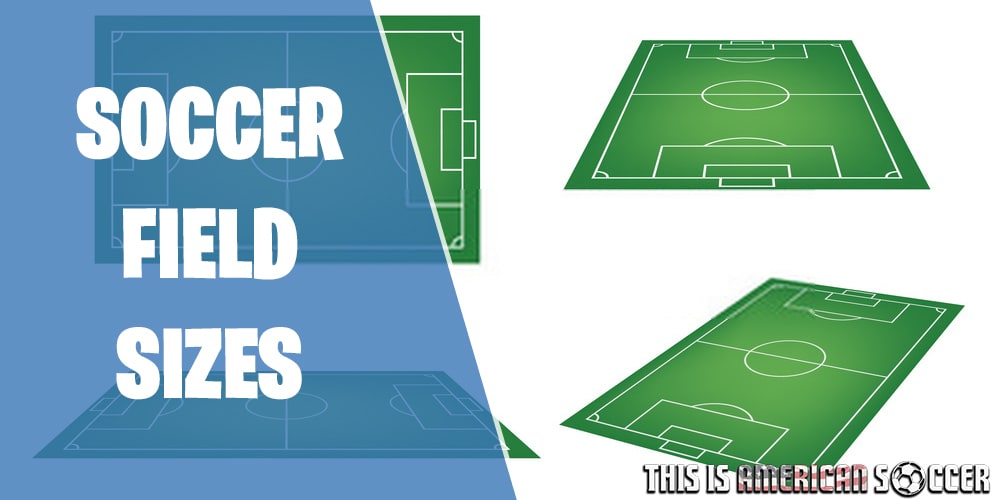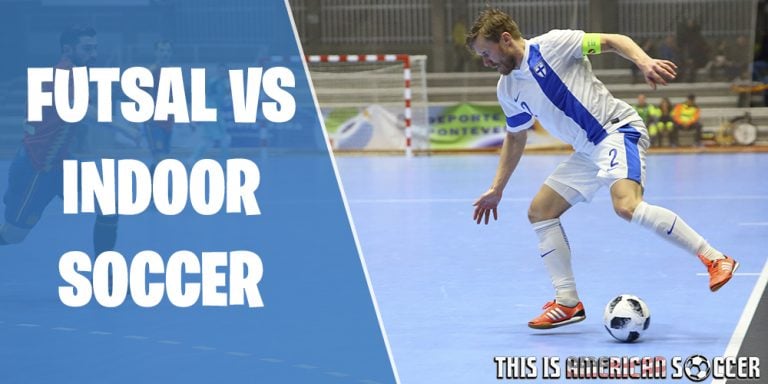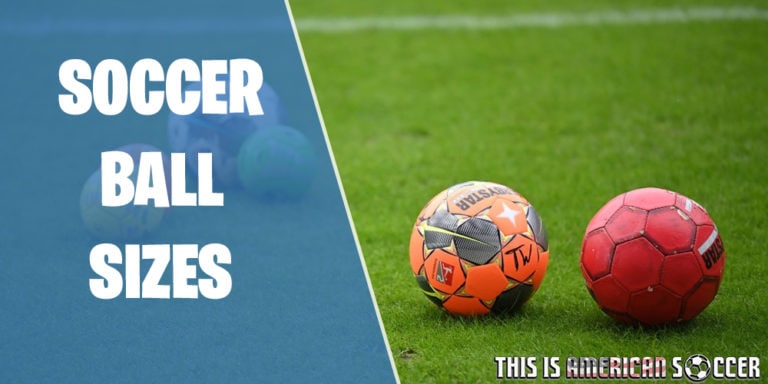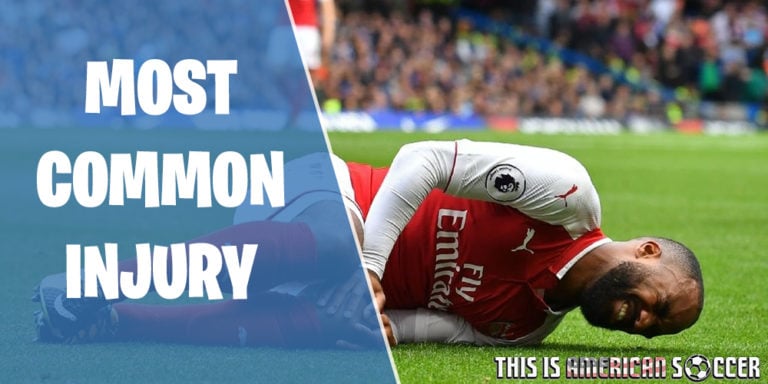In this article we take a look at all the soccer field dimensions that exist, and the sizes of any other soccer fields that are relevant, and how they compare to each other.
A soccer field size varies in shape depending on the governing body and level of play. In this article we will guide you through what those dimensions are, from high school soccer fields to professional fields, and what we need to know.
The Laws of the Game are a set of rules of association football. These laws govern the number of players a team should have, the goal area, the penalty box, how long the game is, the size of the ball, fouls, and last, but not least; the size of the field.
Soccer field sizes
A soccer field (or a football pitch as it is commonly known outside the US) is the field of play (or football field), made typically of turf or artificial turf upon which we play our glorious soccer games, from high school fields to the world cup tournament (see also ‘Is Soccer An Olympic Sport?‘) (see also ‘Is Soccer An Olympic Sport?‘).
But why are there so many different field dimensions, and what influences soccer field sizes?
Well clubs usually set their own sizes within given parameters to suit the style, play and ability of their team.
Here we will look at what those parameters are.
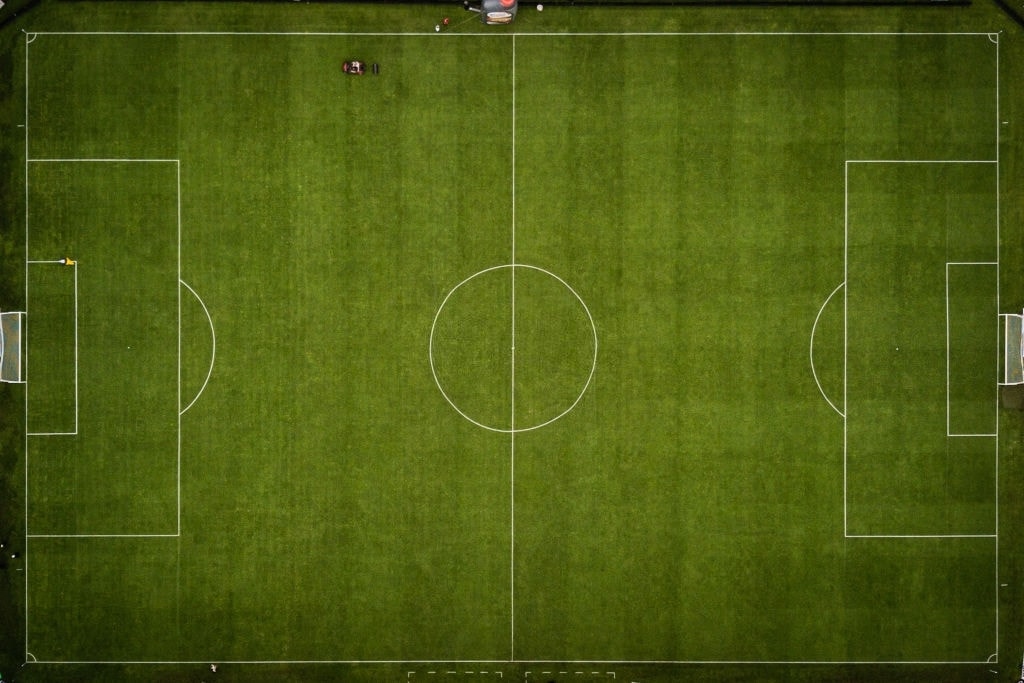
Standard size of a soccer field
Dimensions
The standard for a professional soccer field size as set by the international football association board are measured as follows:
- The field must be rectangular, can not be more than 75 yards wide (68.58 m) or be less than 70 yards (64.01 m) and it must not exceed the length.
- The reach of the field can not be more than 120 yards (109.73 m) or less than 115 yards (105.16 m) Indoor facilities and youth facilities have a unique set of dimensions.
It is the job of the referees or assistant referees to assure that these conditions are met. The Professional Referee Organization (PRO) is the organizing body responsible for managing the referee/assistant referee program in professional leagues.
Boundary lines
The field shall be marked with distinctive boundary lines, the longer line being called the touch line marking the length of the field, and the shorter the goal line, marking the width.
The touch line and goal line must meet at the corners, and the goal line can not extend completely across the field of play, including the area between the goal posts, and the touch lines need to extend the entire length of the field.
Half way line and center circle
The field of play must be marked half way and must cover the entire width of the field.
The center of the field is demonstrated by a circle with a 10-yard (9.14 m) marking around it.
Penalty area
At the end of each field, two lines should be drawn at right angles to the goal line, 18 yards (16.46 m) from the inside of each goal post.
They need to extend into the playing field for 18 yards (16.46 m) and will be joined by a line parallel with the goal line.
The spaces enclosed by these lines and the goal line is known as the penalty area, or penalty box.
At either end of the field, a 2-foot (60.96 cm) line or 9-inch (22.86 cm) spot needs to be placed at a point 12 yards (10.97 m) from the the middle, and parallel to the goal line.
This line needs to extend 1 foot (30.48 cm) on either side of unmarked center line. The spot extends 4½ inches on either side of the center line.
The restraining line for penalty kicks extends 10 yards (9.14 m) in an arc outside of the penalty area and closes on the penalty area line from the center of the penalty kick line/spot.
The distance from the penalty spot to the goal line is 12 yards (11 m) from the goal line, directly in-line with the center of the goal and is normally shaped like a D. This is called a penalty arc.
Markings and measurements
All lines forming a part of the defined areas of the field should be the same width, no less than 4 inches (10.16 cm) and no more than 5 inches (12.7 cm).
Measurements are taken from the outside of each line to the outside line that it converges with.
When measuring the width of the goal and penalty box, the measurements are taken from the inside of the goal post to the outside of the 6- and 18-yard lines. No markings of a commercial nature can be placed on the field.
A halfway line for the center circle must be marked across all soccer fields.
The center of the field has to be be intimated by a suitable mark, and a circle with a 10-yard (9.14 m) radius needs to be marked around it.
Goal area and soccer goals
Soccer goal dimensions are measured as follows;
At each end of the soccer field, two lines must be drawn at right angles to the goal lines, 6 yards (5.49 m) from the inside of each goal post.
These shall extend into the field of play for a distance of 6 yards (5.49 m) and must be joined by a line drawn parallel with the goal line.
Each of the spaces enclosed by these lines and the goal line is called a goal area.
The soccer goal needs to be secured. The goal posts will consist of two posts, of equal distance from the corner flags and 8 yards long (7.32 m) and meet the edge of the crossbar, the lower edge needs to be 8 feet (2.44 m) from the ground.
The diameter of the goal posts and crossbar can be no less than 4 inches (10.16 cm) and no more than 5 inches (12.7 cm).
A net is attached to the uprights and the edge of the crossbar and secured properly and firmly behind each goal.
Corner area
From each corner, a quarter circle, or corner arc with a radius of 1 yard (0.914 m), will be drawn inside the field of play.
In addition to the corner arc, a hash mark 1 yard (0.914 m) in length, situated 6 inches beyond (but not touching) the field of play and 11 yards (10.05 m) from the touch line shall be marked at a 90° angle to the goal line at either corner of the field.
Corner flags
A flag post no less than 5 feet (1.53 m) high should be positioned at each corner. The flag needs to be brightly colored, and easily distinguishable and must not have pointed tips.
The flag posts have to be placed firmly into the ground or shall rise from a sturdy structure and can be no more than 8 inches (20.32 cm) across it’s base.
FIFA soccer field dimensions
A FIFA soccer field is 110–120 yards (100–110 m) long by 70–80 yards (64–75 m) wide.
FIFA soccer field dimensions are wider than the regulation American football field width of 53 1⁄3 yards (48.8 m) respectively, and are held in soccer stadiums. The world cup is held on a FIFA regulated soccer field.
Have a look at page 7 in this official FIFA .pdf document to get more information.
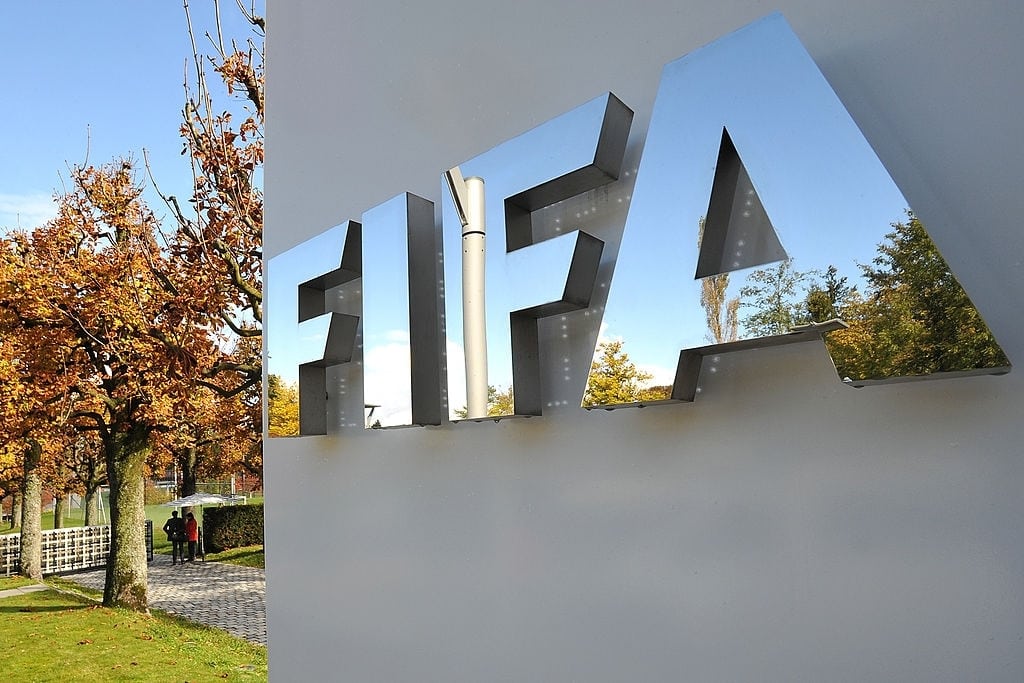
Youth soccer field dimensions
Youth soccer fields, understandably, have a unique set of dimensions for obvious reasons, and vary depending on the age of the player (see also ‘How Many Players Are Part Of A Soccer Team And On The Field‘) (see also ‘How Many Players Are Part Of A Soccer Team And On The Field‘).
Between the ages of 6 and 13, a child’s technique, skill and their ability to play the game develop exponentially.
In the table below you’ll find all youth soccer field dimensions that exist:
| Age | Field width (yards) | Field length (yards) | Field width (meters) | Field length (meters) |
|---|---|---|---|---|
| U6 | 15 - 20 yd | 25 - 30 yd | 13.71 - 18.28 m | 22.86 - 27.43 m |
| U8 | 20 - 25 yd | 30 - 40 yd | 18.28 - 22.86 m | 27.43 - 36.57 m |
| U9 | 30 - 35 yd | 40 - 50 yd | 27.43 - 32.00 m | 36.57 - 45.72 m |
| U10 | 40 - 50 yd | 60 - 70 yd | 36.57 - 45.72 m | 54.86 - 64.00 m |
| U11 | 40 - 50 yd | 70 - 80 yd | 36.57 - 45.72 m | 64.00 - 73.15 m |
| U12 | 40 - 55 yd | 100 - 105 yd | 36.57 - 50.29 m | 91.44 - 96.01 m |
| U13 | 50 - 60 yd | 100 - 110 yd | 45.72 - 54.86 m | 91.44 - 100.58 m |
| Adult | 70 - 80 yd | 110 - 120 yd | 64.00 - 73.15 m | 100.58 - 109.72 m |
College soccer field dimensions
A college soccer field is 70 to 75 yards (64-68.58 m) wide by 115 to 120 yards (105.15-109.72 m) long.
The National Collegiate Athletic Association (NCAA) who is the sports regulating body sets the standard college level soccer field dimensions.
These regulations are set more closely than that of youth soccer to match professional soccer field dimensions, and fit with the FIFA regulated sizes.
It is not the same size as the soccer field used in high schools.
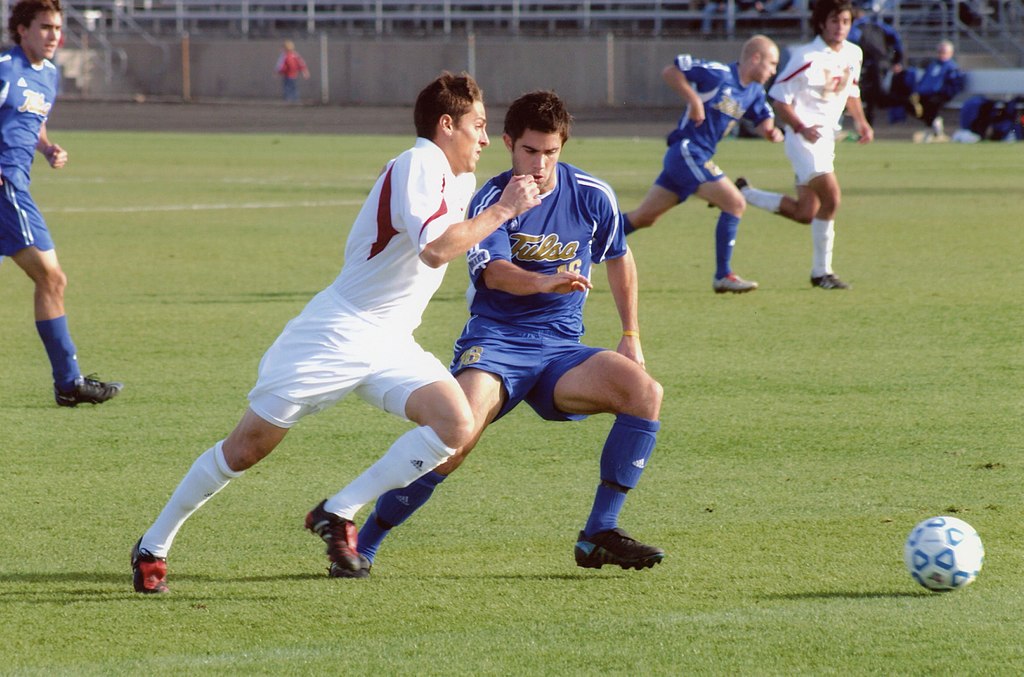
High school soccer field dimensions
Ideally, a high school soccer field is 55 yards (50.29 m) wide by 100 yards (91.44 m) long but can vary to 80 yards (73.15 m) wide and 120 yards (109.72 m) long.
High school field dimension rules are set according to the National Federation of State High School Associations (NFHS).
High school soccer field dimensions are dictated by the suitable space that the individual high school has available to them, but still the ratio must be adhered to, in that the length and width remain proportional.
The requirements for a high school soccer field and FIFA soccer field dimensions are relatively similar, and overlap in certain areas, for this reason there is a possibility that a high school soccer field and a professional soccer field can be the same size…
However, this is rarely the case, and most high school fields are smaller than professional soccer fields.
The reason being that most high schools don’t have a purpose built stadium or field, and the area dedicated to soccer is normally multi-purpose.

Small sided soccer field dimensions
A small sided game is a game with with a small number of players on each side, the most common ones are 3v3, 5v5, 6v6, 7v7 and 9v9.
The benefits are that because there are fewer players, each player gets more touches of the ball, because of the style of play small sided games are extremely good for overall conditioning, coaches who are limited on time with players can concentrate on tactics and technical training, and can reduce training time overall.
In the table below you can find the different dimensions for these small sided soccer fields:
| Game type | Field width (yards) | Field length (yards) | Field width (meters) | Field length (meters) |
|---|---|---|---|---|
| 3v3 | 20 yd | 25 yd | 18.28 m | 22.86 m |
| 5v5 | 30 yd | 40 yd | 27.43 m | 36.57 m |
| 6v6 | 40 yd | 60 yd | 36.57 m | 54.86 m |
| 7v7 | 40 yd | 60 yd | 36.57 m | 54.86 m |
| 9v9 | 50 yd | 75 yd | 45.72 m | 68.58 m |
Futsal field dimensions
A futsal field (or court) shares similarities with 5v5 soccer and varies depending on the nature of the game being played.
The futsal court used for international games is larger than the court used for domestic games and smaller than soccer fields or a football pitch. (There are no permanent boundaries around a futsal court.)
International game
Width: between 59.5-72.17 ft (18-22 m).
Length: between 124.6-137.7 ft (38-42 m).
The radius of the center circle is 9.84 ft (3 m).
Domestic game
Width: between 49.21-82.02 ft (15-25 m).
Length: between 82.02-137.7 ft (25 to 42 m).
The radius of the center circle is 9.84 ft (3 m).

Indoor soccer field dimensions
Games for indoor soccer are played on turf or artificial turf, with a total of 6 players over 60 minutes with a soccer ball.
The area of play is larger than that of a futsal court and it also has no walls.
The dimensions vary slightly between governing bodies. The following dimensions are given using the most universal rules from association football.
Width: 85ft (25.90 m).
Length: 200 ft (60.96 m).
The radius of the center circle is 9.84 ft (3 m).
Soccer field diagram
Below you can see a soccer field diagram with all the sizes of a soccer field you need to know.
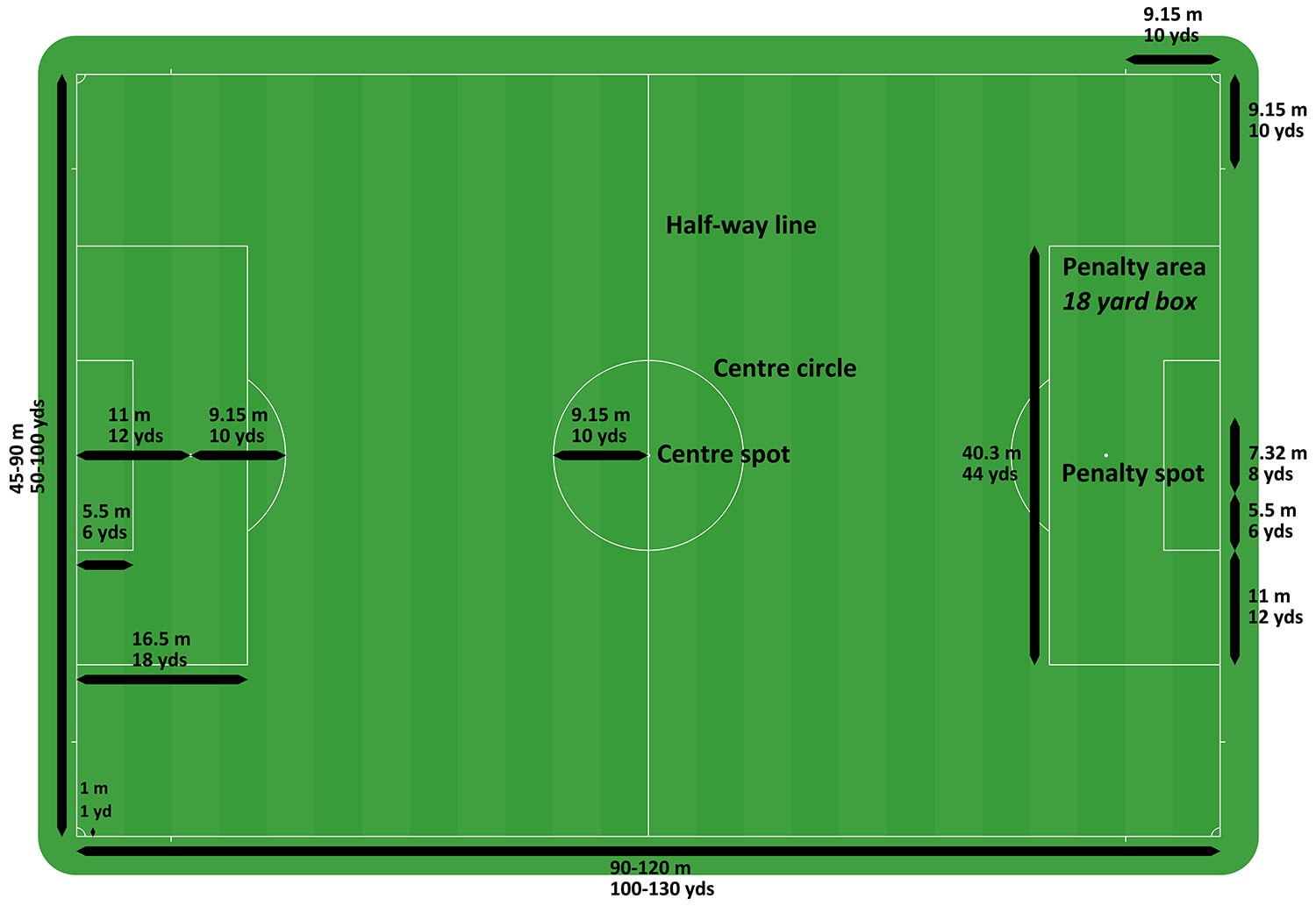
You can also have a look at this NCAA .pdf file to get even more data and information.
Soccer field vs American football field
Soccer and American football fields are usually the same lengths as each other. However, the space is divided differently.
Between the goal lines of an American football field, there are 100 yards (91.5 m) and when you include the two 10-yard end zones the length comes to 120 yards (109.72 m).
The measurements are as follows:
American football field
An American football field is 100 yards (91.44 m) long by 53.3 yards (48.8 m). Additional to this there are two end zones measuring 10 yards (9.14 m). So the total length is 120 yards. (109.72 m).
Soccer field
The size of a standard soccer field is:
Touch line (length): 100 yd (90 m) to 130 yd (120 m)
Goal line (width) : 50 yd (45 m) to 100 yd (90 m)
The size of an international field is:
Touch line (length): 110 yd (100 m) to 120 yd (110 m)
Goal line (width) : 70 yd (64 m) to 80 yd (75 m)
Looking for related or relevant sources?
Below you find a list with all the relevant or related sources we’ve used:
- https://en.wikipedia.org/wiki/Futsal
- https://en.wikipedia.org/wiki/Indoor_soccer
- https://en.wikipedia.org/wiki/Soccer-specific_stadium
- https://en.wikipedia.org/wiki/College_soccer
- https://en.wikipedia.org/wiki/International_Football_Association_Board
- https://www.sportsfeelgoodstories.com/soccer-field-dimensions-size-diagram/
- https://bsbproduction.s3.amazonaws.com/portals/7048/docs/field%20sizes.pdf
- https://www.bcsoccer.net/files/AboutUs/BylawsRulesRegsPolicies/Small%20Sided%20Rules_updated_September_2020.pdf
- https://www.footballscience.net/training/aerobic-endurance/small-sided-games/
- https://www.diffen.com/difference/American_Football_vs_Soccer
Looking for articles that are similar or relevant to soccer field dimensions?
Below you find a list with all our articles that relate to this topic:

